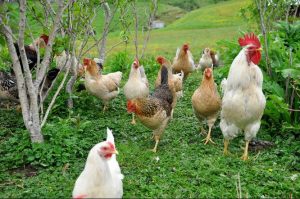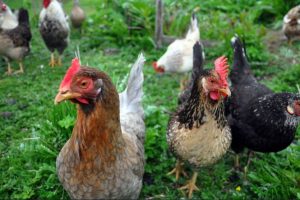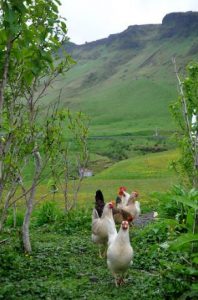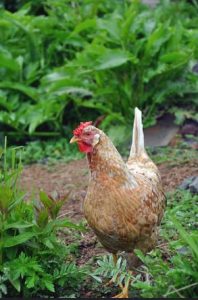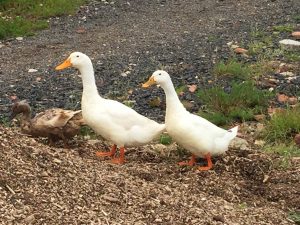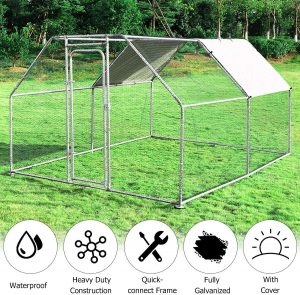Icelandic Breed Overview
The Icelandic chicken also known to some as the Viking chicken, has some of the most colorful history of all the breeds of chickens.
Norse Vikings from Norway and Scandinavia brought this breed with them to Iceland by boats in around the 8th century. In fact in Iceland they are still known as ‘Íslenska landnámshænan’ which means Icelandic chicken of the settlers.
Those same Vikings when landing their boats in Iceland, would have been ‘’off grid’’! So hundreds of miles from home they would need a chicken that would produce eggs, so they could live within the icey, snowy landscape. But they firstly needed a tough chicken, that would survive the sea passage and the Icelandic was just that.
The breed remained in Iceland for 1200 years, living wild and free range and would have then bred naturally themselves, with no input by humans trying to develop things like feather colors or for show quality birds.
This then meant the strongest cockerel would have bred with the best hens producing the toughest offspring. This produced an incredibly resilient, cold hardy chicken that is an expert forager. It also means as a line of ‘’pure’’ ‘’thoroughbred’’ chickens the Icelandic can’t really be matched by any other breed.
However in around the 1900’s Iceland began to import chickens from other countries like England, America and Asia to breed with the native ‘pure’ Icelandic’s in an attempt to create a cross breed that was capable of producing either more eggs per year or a better bird for meat consumption.
This has led to a diluted gene pool and some of the traits the original pure bred possessed to be lost. It did though create fabulous colors and patterns of Icelandic chickens that we can still see today.
Today’s Icelandic Chickens
Luckily in the 1970’s there was a conservation effort to protect the ‘original’ birds that hadn’t been crossed with other breeds and these can be still bought today.
Icelandic winters are dark and cold and these birds adapted well over the 1200 years they have been there. This has made them great winter chickens, laying steady over the winter months.
They are a fairly small breed with males weighing 4.4-5.5lbs and hens just 3-3.5lbs. This makes them perfect for your flock if you are short on space, want to help preserve the breed or just are in love with the amazing variety of color and patterns.
Eggs
Size
Small – to just below Medium size [which is impressive for a relatively small hen]
Color
White to a creamy off white color
Production per year
160-200 eggs per year
When do they start laying eggs?
18-24 weeks old
Icelandic Characteristics
Temperament / Are they good as pets?
This depends entirely on whether you have the ‘pure’ breeds with all the characteristics and traits mentioned above or a cross breed.
Pure breeds and ‘crosses’ both tend to be flighty. This is because back in the self-sufficient wild, they had to be alert to danger and react quickly to stay alive. With this said once they know they are in a safe environment with people who care for them, they become gradually less flighty.
Being good fliers was important in the wild as it meant they could escape danger from the ground and could also roost for the night in high tree branches.
Average winters in Iceland as you can imagine by the name get fairly cold. Around -10C in the capital that’s 14F. So they are a cold hardy bird and great if you live in cooler climates or have cold winters. Summers in Iceland are on average 10–13 °C (50–55 °F) sometimes reaching 20-25°C so I wouldn’t expect Icelandic’s to be very heat heady, unless cross bred with a breed which is.
They get broody over the summer, as that is naturally when in the wild they would have had their chicks, in the warmer weather to ensure good survival rates. They make great mothers too, taking very good care of the chicks.
So would be ideal if you plan to hatch out some chicks or increase the numbers of Icies [the short term given to Icelandic’s] in your flock.
They didn’t take well to raising any other breeds of chickens from hatching [often called foster mothering], but that was just my own experience.
How do I tame Icelandic chickens?
They can be naturally inquisitive, whether that was to figure out if something was dangerous or a potential food source, so I would start there. Some treats will build up a bond with them but it will be slowly. Being excellent foragers they aren’t as reliant on humans as other breeds are for food.
The best way to tame Icies is to have them from chicks. Handle them 3-4 times a day and this will get them used to human interaction and you’ll have them cuddling you in no time.
How many do I need to buy?
It’s never recommended to keep chickens by themselves. It always best to have at least a pair, as chickens are social creatures that enjoy interaction with other chickens.
A great backyard flock size is around 6 chickens, from there it’s easy to scale up the size of the flock numbers.
How much space do they need?
Being independent birds they are used to be out foraging and so they naturally prefer free range conditions not total confinement.
The minimum space in the coop required is 3-4 sq foot per bird and in the run I’d say no less than 15sqft per bird with Icelandic’s. Normally with smaller birds or bantams, which they are often confused for due to their size, they require slightly less run space at a minimum of 8sqft per bird but this makes for very unhappy Icelandic’s who need to stretch their legs. More space or free range is therefore best.
Normally signs of an ‘unhappy’ Icy is it constantly walking/pacing up and down the chicken wire, not foraging or scratching, looking for a way out. If you see this they require much more space than you are allowing. They won’t lay as well either in an environment where they are unhappy.
They like to roost high up, a lot like most other small birds or bantams, so will need a roost perch to accommodate this. They won’t take up too much space on the perch width wise, probably only 8 inches max. By width space I’m referring to ‘wing to wing’ measurements.
In a free range setting they will thrive. But at first it might be difficult to get them back into the coop at night. You could be outside having to ‘encourage’ them to go into the coop to roost for the night, just for the first couple of weeks.
You may at first, actually find them happily roosting on the fence or even on the chicken coop roof itself. They are real characters.
Will they mix with my other chickens?
Yes they will, they are small and not known to be aggressive but will ‘stick up for themselves’ if attacked or bullied. However introducing new chickens to any flock requires vigilance and isn’t recommended in numbers of less than 2 birds at a time. That way they have a ’buddy’.
Appearance
They really do come in all colors and patterns. Hatching out chicks from eggs is therefore a total lottery. You never know what colors you are likely to get. It’s very fun in that aspect.
True ‘pure’ Icelandics will not have any feathers on the legs or have ‘muffs’ or ‘beards’.
My theory on this is the natural patterns and colors on Icelandics are, like in other areas of the animal kingdom, for protection. Camouflage is natures best weapon for survival and large blocks of colors or feather patterns would get easily spotted.
For instance a Rhode Island Red would be easy to spot in snow as they are one color. However they would be more difficult to spot, sat in a tree with chestnut/brown tree bark as a backing.
Given the environment in Iceland which can be white, snowy and barren in the winter, but green and rocky in the summer. Having a good variety of coloring and patterns on a bird would help hide it all year round whilst it was out foraging in the day and sleeping at night. They survived all alone for 1200 years in Iceland, they must be doing something right!
Feeding
What should I feed them?
They will require grit. Grit for chickens often comes in the form of oyster shells that are crushed up, but not too finely as it’s not a powder. Grit contains calcium, a key ingredient to help chickens produce egg shells.
Where did Icelandic’s in the wild find these food sources?
Calcium is a mineral found in soil, then it is absorbed from the soil into the roots of plants. Well, being expert foragers, they actually prefer to be scratching around in organic piles of debris hoping to find new green shoots to eat. Fallen trees covered in moss also contain grubs and worms and Icies go mad for these fresh protein sources. They may have possibly been eating wild mushrooms too, as these are found in abundance in Iceland.
Iceland is famous for its ‘fjords’ which would have brought in ‘Lithothamnion calcareum’ a living edible red algae that grows just off coast of Iceland, it’s extremely calcium rich at over 30%.
As backyard pets then, they still require a rich diverse diet. Corn, seeds nuts etc, but most importantly the access to forage for their own dietary requirements. For this reason if kept in a fenced off area you could have a pile of chipped tree bark or a vegetable compost area. That would keep them really happy. Ours love it and even the ducks are have a forage around in it…
Perhaps look at a Scratch and Pecks organic range of food, as you need quality food sources for Icies. Adding Apple Cider Vinegar to the water could really help boost the nutrients and vitamins they also need. Check out our page here dedicated to ACV.
How much should I feed them?
Icies will typically eat between 2.8oz-3.5oz (80-100g) per day per bird. When they can forage they will require less feed from you, as they find their own meals. They are great chickens to have if you want your feed bill slashed. Females weighing more than 3.6lbs would be considered to be eating too much or haven’t access to enough open space.
Although this isn’t always recommended by everyone as it can encourage waste and vermin, I would scatter some feed daily on the ground. Icies and other foraging birds will love scratching around looking for the bits of corn or seeds and this will keep them really happy. I probably place 90% in the feeder and scatter the remaining 10%.
What can’t they eat?
There are things all chickens can’t eat, two of those are beans, dried beans being worse than non-dried. The other item is chocolate. Both can cause chickens to cardiac arrest, it’s very serious.
With such a free ranging bird you need to be particularly careful that they can’t access beans, if you grow them in your backyard or your neighbor does – I did say they were good fliers!
You need to be vigilant if feeding chickens scraps from the table too, this is often how beans can creep into an Icelandic’s diet. Feeding chickens scraps in the UK is banned.
What do I need to keep chickens?
They will need a coop to live in!
Remember, preferably high roost bars with nesting boxes lower than the bars or they will roost in those instead. The roost boxes shouldn’t be directly underneath the roost bars, as they will poop into them whilst sleeping.
If you want to have them ‘semi free range’ as you need to protect them from predators due to the area you live in, like foxes or coyotes etc I’d recommend a large Giantex. Its light weight making it easy to assemble and to move to fresh grass if you needed to.
Fully free range, you still need a good high fence. As they can fly, if you want them to stay in, a net over the top will also be required for sure! If you want even more protection an electric fence round the outside of it works well.
I have this option now after many visits from Mr Fox!
Honestly, fully free range is best with Icelandic’s, its where they are most happiest and will lay you loads of amazing eggs.
Waterer
They will need a waterer to drink from, place this down on flat ground in the shade, and this will help keep it cool. Chickens actually prefer cool water.
I wouldn’t recommend a fount style waterer in a coop as it’s messy and gets dirty quickly. That will ruin the bedding on the floor, if you place it down and if you don’t the water spilling from the fount will rot the floor.
Try a nipple style waterer in the coop. If you do live in a cold area and that’s why you want an Icy, for its cold hardiness, you can buy heated chicken waterers or bases to heat a drinker. This means it has access to water all the time, without you worrying, or having to come out in the cold to break the ice so they can drink.
Galvanized metal is best versus plastic as it lasts so much longer, its heavier so is less likely to be knocked over, can be sanitized with boiling water and will keep the water cooler for longer. Plastic when exposed to heat and cold just cracks and splits.
Well that’s all you need to know about Icelandic chickens, best of luck – you’ll have so much fun!
Icelandic Chickens for Sale
They can be hard to come across, try this Facebook group:
https://www.facebook.com/groups/icelandicchickens
And try this farm if you are in the US, for pure breeds imported from Iceland
https://www.redfeatherfarm.net/shop/day-old-straight-run-chicks/icelandic-chicks/

Attributes for the photos go to Jennifer Boyd

